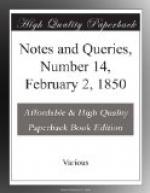In the same volume of MSS. (art. 61.) there is the description of a dagger “with a hefte of white Caredon.”
From the size of the cross described, “Emerod” can scarcely be read “Emerald,” as applied by us to one of the precious stones.
Is “white Caredon” white cornelian?
Can any of your numerous correspondents give me a note in answer to the above queries?
D.
46. Parliament Street, Westminster, Jan. 25. 1850.
Microscope, and Treatise upon it.—I am about to commence the study of the microscope. I want to know where I can purchase the most perfect instrument, and also the best Treatise upon it; this information will indeed be valuable to me, as it would enable me to go at once to the best sources without loss of time.
R.M. JONES.
Chelsea, Jan. 2. 1850.
Old Auster Tenements.—“W.P.P.” wishes to know the meaning of the expression “Old Auster Tenements,” by which certain lands in the parish of North Curry, Somerset, are described in Deeds and Court Rolls.
* * * * *
REPLIES
THE FIELD OF FORTY FOOTSTEPS.
The fields behind Montague House were, from about the year 1680, until towards the end of the last century, the scenes of robbery, murder, and every species of depravity and wickedness of which the heart can think. They appear to have been originally called the Long Fields, and afterwards (about Strype’s time) the Southampton Fields. These fields remained waste and useless, with the exception of some nursery grounds near the New Road to the north, and a piece of ground enclosed for the Toxophilite Society, towards the northwest, near the back of Gower Street. The remainder was the resort of depraved wretches, whose amusements consisted chiefly in fighting pitched battles, and other disorderly sport, especially on the Sabbath day. Such was their state in 1800.
Tradition had given to the superstitious at that period a legendary story of the period of the Duke of Monmouth’s Rebellion, of two brothers who fought in this field so ferociously as to destroy each other; since which, their footsteps, formed from the vengeful struggle, were said to remain, with the indentations produced by their advancing and receding; nor could any grass or vegetable ever be produced where these forty footsteps were thus displayed. This extraordinary arena was said to be at the extreme termination of the northeast end of Upper Montague Street; and, profiting by the fiction, Miss Porter and her sister produced an ingenious romance thereon, entitled, Coming Out, or the Forty Footsteps. The Messrs. Mayhew also, some twenty years back, brought out, at the Tottenham Street Theatre, an excellent melodrama piece, founded upon the same story, entitled The Field of Forty Footsteps.




